Themed collection Adsorption and degradation of pollutants

A critical review on arsenic removal from water using iron-based adsorbents
The recent developments on iron-based adsorbents such as iron oxyhydroxides nanoparticles, zero-valent iron, bimetallic oxides, and iron oxyhydroxide-doped composite materials are fully discussed in this review.
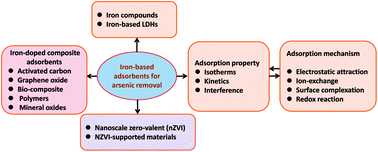
RSC Adv., 2018,8, 39545-39560
https://doi.org/10.1039/C8RA08512A
Regeneration performance of clay-based adsorbents for the removal of industrial dyes: a review
The present review covers the regeneration capacity and adsorption efficiency of different adsorbents for the treatment of industrial dyes to control water pollution.
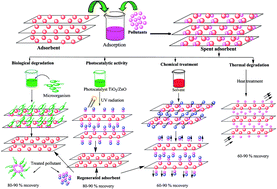
RSC Adv., 2018,8, 24571-24587
https://doi.org/10.1039/C8RA04290J
Adsorptive environmental applications of MXene nanomaterials: a review
Due to their large specific surface area and abundant active surficial sites, MXenes can adsorb various environmental pollutants.

RSC Adv., 2018,8, 19895-19905
https://doi.org/10.1039/C8RA03077D
Utilization of LDH-based materials as potential adsorbents and photocatalysts for the decontamination of dyes wastewater: a review
This review introduces briefly the use of LDH materials as adsorbents and catalysts for the decontamination of dyes wastewater.
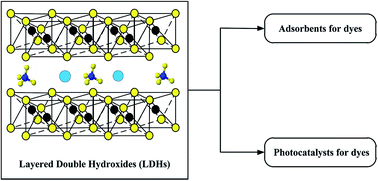
RSC Adv., 2016,6, 79415-79436
https://doi.org/10.1039/C6RA12727D
The removal of heavy metal ions from wastewater/aqueous solution using polypyrrole-based adsorbents: a review
Water pollution caused by heavy metal ions is becoming a serious threat to human and aquatic lives day by day.
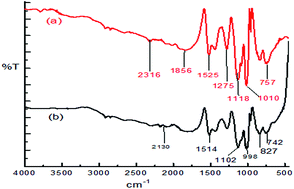
RSC Adv., 2016,6, 14778-14791
https://doi.org/10.1039/C5RA24358K
Principles and mechanisms of photocatalytic dye degradation on TiO2 based photocatalysts: a comparative overview
Pictorial representation of all possible dye degradation reaction in UV light initiated indirect dye degradation mechanism. This mechanism is practically more important over visible light initiated direct mechanism.
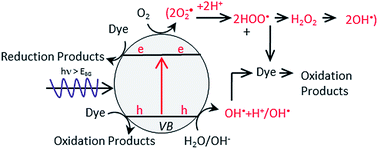
RSC Adv., 2014,4, 37003-37026
https://doi.org/10.1039/C4RA06658H
Photocatalytic degradation of methylene blue in ZIF-8
ZIF-8 was used to perform photocatalytic degradation of methylene blue, a typical organic dye.
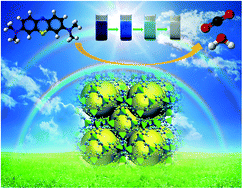
RSC Adv., 2014,4, 54454-54462
https://doi.org/10.1039/C4RA08820D
Engineered Fe3 triangle for the rapid and selective removal of aromatic cationic pollutants: complexity is not a necessity
A Fe3 triangle has been designed to serve as a filter for the elimination of cationic dye pollutants.
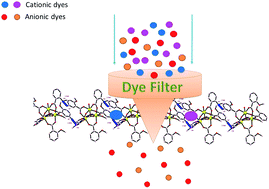
RSC Adv., 2021,11, 2630-2642
https://doi.org/10.1039/D0RA09586A
Glauconite clay-functionalized chitosan nanocomposites for efficient adsorptive removal of fluoride ions from polluted aqueous solutions
We herein have developed a mild approach for the fabrication of glauconite clay (G)-modified chitosan (CS) nanocomposites by the combination of a simple blending and crosslinking method.
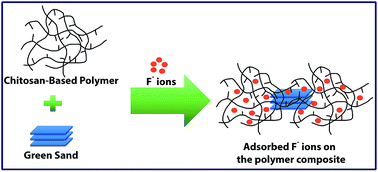
RSC Adv., 2020,10, 25567-25585
https://doi.org/10.1039/D0RA02340J
Metal (Cd, Cr, Ni, Pb) removal from environmentally relevant waters using polyvinylpyrrolidone-coated magnetite nanoparticles
PVP–Fe3O4 NPs synthesized with no organic solvents, low toxicity reactants and low temperature/energy requirements could remove Cd, Cr, Ni, Pb efficiently in the different synthetic water media under environmentally relevant conditions.

RSC Adv., 2020,10, 3266-3276
https://doi.org/10.1039/C9RA10104G
A direct Z-scheme Bi2WO6/NH2-UiO-66 nanocomposite as an efficient visible-light-driven photocatalyst for NO removal
To explore an efficient photocatalyst for NO pollution, a direct Z-scheme photocatalytic system is successfully fabricated by coupling Bi2WO6 with NH2-UiO-66 via a simple hydrothermal synthesis technique.
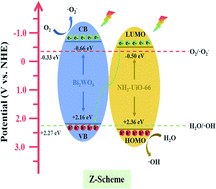
RSC Adv., 2020,10, 1757-1768
https://doi.org/10.1039/C9RA09270F
A facile preparation method for new two-component supramolecular hydrogels and their performances in adsorption, catalysis, and stimuli-response
New two-component supramolecular hydrogels were prepared via a self-assembly process, demonstrating potential applications in adsorption and catalysis as well as sensor materials.

RSC Adv., 2019,9, 22551-22558
https://doi.org/10.1039/C9RA03827B
Adsorption of mercury(II) with an Fe3O4 magnetic polypyrrole–graphene oxide nanocomposite
The Fe3O4 magnetic polypyrrole–graphene (PPy–GO) has a Langmuir adsorption capacities of 400.0 mg g−1 for Hg(II). And it has a favorable saturation magnetization of 19.0 emu g−1, easily separated from solutions via additional exterior magnets.
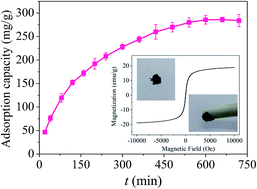
RSC Adv., 2017,7, 18466-18479
https://doi.org/10.1039/C7RA01147D
Enhanced adsorptive removal of anionic and cationic dyes from single or mixed dye solutions using MOF PCN-222
MOF PCN-222 exhibits excellent adsorption/removal capacities for numerous anionic and cationic dyes individually and together in solutions.

RSC Adv., 2017,7, 16273-16281
https://doi.org/10.1039/C7RA01647F
Comparative study of the photocatalytic performance for the degradation of different dyes by ZnIn2S4: adsorption, active species, and pathways
Comparative study of the photocatalytic performance for the degradation of different by ZnIn2S4 based on the adsorption of dyes, the active species and the degradation pathway.

RSC Adv., 2017,7, 12292-12300
https://doi.org/10.1039/C7RA00199A
Heavy metals removal by EDTA-functionalized chitosan graphene oxide nanocomposites
Graphene-based two-dimensional materials have been explored in a variety of applications, including the treatment of heavy-metal-rich water/wastewater.
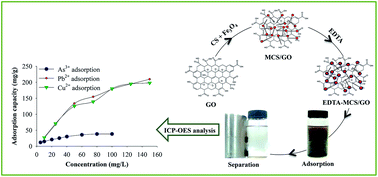
RSC Adv., 2017,7, 9764-9771
https://doi.org/10.1039/C6RA28406J
In situ TEMPO surface functionalization of nanocellulose membranes for enhanced adsorption of metal ions from aqueous medium
The current work demonstrates an innovative approach to develop nanocellulose based membranes via in situ TEMPO functionalization of the thin functional layer of cellulose nanocrystals (CNCBE) to enhance the metal ion adsorption capacity.

RSC Adv., 2017,7, 5232-5241
https://doi.org/10.1039/C6RA25707K
Cobalt ferrite nanoparticles via a template-free hydrothermal route as an efficient nano-adsorbent for potential textile dye removal
We have reported herein the preparation of a pure cobalt ferrite (CoFe2O4) nanostructure, as an efficient nano-adsorbent, via a template-free hydrothermal and post thermal conversion route.

RSC Adv., 2016,6, 79688-79705
https://doi.org/10.1039/C6RA12852A
Statistical experimental design, least squares-support vector machine (LS-SVM) and artificial neural network (ANN) methods for modeling the facilitated adsorption of methylene blue dye
This study is based on the usage of a composite of zinc sulfide nanoparticles with activated carbon (ZnS-NPs-AC) for the adsorption of methylene blue (MB) from aqueous solutions.
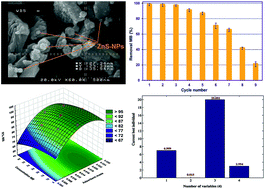
RSC Adv., 2016,6, 40502-40516
https://doi.org/10.1039/C6RA01874B
Optimization of the process parameters for the adsorption of ternary dyes by Ni doped FeO(OH)-NWs–AC using response surface methodology and an artificial neural network
The present study deals with the simultaneous removal of chrysoidine G (CG), rhodamine B (RB) and disulfine blue (DB) by Ni doped ferric oxyhydroxide FeO(OH) nanowires on activated carbon (Ni doped FeO(OH)-NWs–AC).
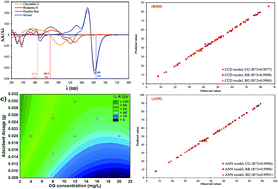
RSC Adv., 2016,6, 19768-19779
https://doi.org/10.1039/C5RA26036A
Removal of cationic and anionic dyes from aqueous solution with magnetite/pectin and magnetite/silica/pectin hybrid nanocomposites: kinetic, isotherm and mechanism analysis
Novel adsorbents, magnetite nanoparticles modified with pectin shell and silica/pectin double shell, were fabricated and tested for single dye and dye mixture adsorption from water samples.

RSC Adv., 2016,6, 11461-11480
https://doi.org/10.1039/C5RA23452B
Removal of basic dye Auramine-O by ZnS:Cu nanoparticles loaded on activated carbon: optimization of parameters using response surface methodology with central composite design
FESEM images of the prepared ZnS:Cu-NPs-AC.
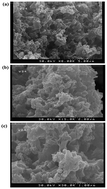
RSC Adv., 2015,5, 18438-18450
https://doi.org/10.1039/C4RA15637D
Graphene oxide-iron oxide and reduced graphene oxide -iron oxide hybrid materials for the removal of organic and inorganic pollutants
GO-iron oxide and RGO-iron oxide composites were synthesized and used for pollutant removal.
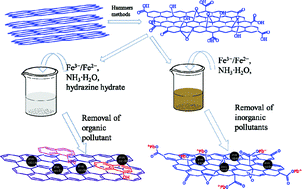
RSC Adv., 2012,2, 8821-8826
https://doi.org/10.1039/C2RA20885G
Batch and bulk removal of hazardous colouring agent Rose Bengal by adsorption techniques using bottom ash as adsorbent
In this paper, adsorption methods are used for the removal of Rose Bengal from aqueous solutions.

RSC Adv., 2012,2, 8381-8389
https://doi.org/10.1039/C2RA21351F
About this collection
We are very pleased to present our 10th Anniversary collection on Adsorption and degradation of pollutants!
Looking back over the last 10 years, we would like to showcase some of the very best articles that have been published in RSC Advances. Many of these papers have been cited hundreds of times, providing valuable advances for further research, and some continue to be among the journal’s most downloaded articles as of today.
We hope you enjoy our 10th Anniversary collection on Adsorption and degradation of pollutants!